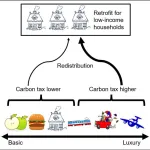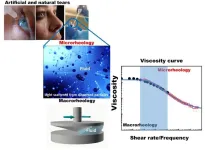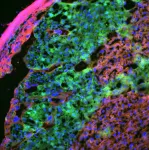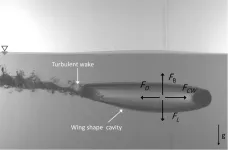(Press-News.org) ITHACA, N.Y. -- Filmmakers may soon be able to stabilize shaky video, change viewpoints and create freeze-frame, zoom and slow-motion effects – without shooting any new footage – thanks to an algorithm developed by researchers at Cornell University and Google Research.
The software, called DynIBar, synthesizes new views using pixel information from the original video, and even works with moving objects and unstable camerawork. The work is a major advance over previous efforts, which yielded only a few seconds of video, and often rendered moving subjects as blurry or glitchy.
The code for this research effort is freely available, though the project is at an early stage and not yet integrated into commercial video editing tools.
“While this research is still in its early days, I’m really excited about potential future applications for both personal and professional use,” said Noah Snavely, a research scientist at Google Research and associate professor of computer science at Cornell Tech and in the Cornell Ann S. Bowers College of Computing and Information Science.
Snavely presented this work, “DynIBaR: Neural Dynamic Image-Based Rendering,” at the 2023 IEEE/CVF Conference on Computer Vision and Pattern Recognition, on June 20, where it received an honorable mention for the best paper award. Zhengqi Li, Ph.D. ’21, of Google Research was the lead author on the study.
“Over the last few years, we’ve seen major progress in view synthesis methods – algorithms that can take a collection of images capturing a scene from a discrete set of viewpoints, and can render new views of that scene,” said Snavely. “However, most of these methods fail on scenes with moving people or pets, swaying trees and so on. This is a big problem because many interesting things in the world are things that move.”
Existing methods to render new views of still scenes, such as ones that make a photo appear 3D, take the 2D grid of pixels from an image and reconstruct the 3D shape and appearance of each object in the photo. DynIBar takes this a step further by also estimating how the objects move over time. But considering all four dimensions creates an incredibly difficult math problem.
The researchers simplified this problem by using a computer graphics approach developed in the 1990s called image-based rendering. At the time, it was difficult for traditional computer graphics methods to render complex scenes with many small parts – such as a leafy tree – so graphics researchers developed methods that take images of a scene and then alter and recombine the parts to generate new images. In this way, most of the complexity was stored within the source image and could load faster.
“We incorporated the classic idea of image-based rendering and that makes our method able to handle really complex scenes and longer videos,” said co-author Qianqian Wang, a doctoral student in the field of computer science at Cornell Tech. Wang developed a method to use image-based rendering to synthesize new views of still images, which the new software builds on.
Despite the advance, these features may not be coming to your smartphone any time soon. The software takes several hours to process just 10 or 20 seconds of video, even on a powerful computer. In the near-term, the technology may be more appropriate for use in offline video editing software, Snavely said.
The next hurdle will be figuring out how to render new images when pixel information is lacking from the original video, such as when the subject moves too fast or the user wants to rotate the viewpoint 180 degrees. Snavely and Wang envision that soon it may be possible to incorporate generative AI techniques, such as text-to-image generators, to help fill in those gaps.
Forrester Cole and Richard Tucker from Google Research also contributed to the research.
-30-
END
Software creates entirely new views from existing video
2023-07-11
ELSE PRESS RELEASES FROM THIS DATE:
Working to make steel greener, cleaner
2023-07-11
CLEVELAND–Case Western Reserve University chemical engineer Rohan Akolkar is leading a research team working to develop a new zero-carbon, electrochemical process to produce iron metal from ore.
If successful, the project could be a first step toward eliminating harmful greenhouse gas emissions by eventually replacing century-old, blast-furnace ironmaking with a new electrolytic-iron production process.
Reducing iron ore to metal is carbon- and energy-intensive, leading to significant carbon-dioxide emissions that drive global warming.
“We don’t use carbon at all in our process, so ...
Crawford Lake chosen as the primary marker to identify the start of the Anthropocene epoch
2023-07-11
EMBARGOED: Not for Release Until 18:00 BST 11 July 2023.
Crawford Lake chosen as the primary marker to identify the start of the Anthropocene epoch
Anthropocene proposes human activity has become a dominant influence on the planet, especially since the mid-twentieth century
Nuclear bomb tests have left a ‘stark plutonium fingerprint’ of this change in human activity
Evidence from Crawford Lake in Canada and 12 secondary locations will be assessed by International Commission on Stratigraphy to decide if we have entered a new geological era
Today [11 July 2023] an international team of researchers has chosen the location ...
New study finds U.S. military veterans living in discriminatory ‘redlined’ areas suffered higher rates of cardiovascular disease
2023-07-11
CLEVELAND—U.S. military veterans who lived in what were once known as “redlined” areas had a higher risk for heart attacks and other cardiovascular issues, according to a new study by researchers at Case Western Reserve University, University Hospitals and the Cleveland VA Medical Center.
In the 1930s, the federal government-sponsored Homeowners’ Loan Corp. (HOLC) established maps of U.S. neighborhoods that identified levels of mortgage risk. This practice led to disinvestments and segregation in “redlined” neighborhoods.
Judicial rulings--and, later, federal legislation--prohibited such government practices, but research has shown their ...
$1.5 million donation supports research on effects of psychedelic DMT on the brain
2023-07-11
One of the most powerful psychedelics known, N,N-dimethyltryptamine (DMT) has been described as causing imaginative visuals akin to the dream state. It is typically consumed on its own or in ayahuasca, a ceremonial brew that has been used for spiritual and visionary purposes by indigenous cultures for centuries. Some have expressed that DMT helped address psychological ailments such as depression and addiction, promoting emotional well-being. However, the way that DMT impacts the brain, body and health is largely unknown.
A ...
Carbon taxes that focus on luxury consumption are fairer than those that tax all emissions equally
2023-07-11
Not all carbon emissions are made for the same reason—they range from more essential purposes like heating a home to nonessential “luxury” activities like leisure travel. However, proposals for the implementations of carbon taxes tend to apply to all emissions at an equal rate. This can give rise to and exacerbate inequalities. A new analysis published on July 11 in the journal One Earth suggests taxing luxury carbon emissions at a higher rate instead; if all 88 countries analyzed in this study adopted the luxury-focused policy, this would achieve 75% of the emissions reduction needed to reach the Paris Agreement’s goal of limiting climate change ...
Thermal cloak passively keeps electric vehicles cool in the summer and warm in the winter
2023-07-11
When an electric vehicle is parked outside, its temperature can swing wildly from day to night and season to season, which can lead to deterioration of the battery. To dampen these fluctuations and extend the battery’s lifespan, researchers have designed an all-season thermal cloak that can cool an electric vehicle by 8°C on a hot day and warm it by 6.8°C at night. The cloak, made predominantly of silica and aluminum, can do so passively without outside energy input and operates without any modification between hot or cold weather. This prototype is described July 11 in the newly launched Device, an application-oriented sister journal ...
Breaking into tears with microrheology to design custom eye drops
2023-07-11
WASHINGTON, July 11, 2023 – Compared to artificial tears, or eye drops, human tears are significantly more complex liquids, with a wide range of components including lipids, carbohydrates, proteins, water, and salt. It is this complex mixture that gives tears the perfect thickness and ability to moisturize the eye, a design that is hard to replicate with fewer ingredients.
In Physics of Fluids, from AIP Publishing, Vega et al. researched human tears at the micron level to reveal new ways of customizing artificial tears to address individual symptoms of dry eye disease. The detailed insights they gained about the composition and behavior ...
Unborn babies use ‘greedy’ gene from dads to ‘remote-control’ mums into feeding them extra food
2023-07-11
Unborn babies use ‘greedy’ gene from dads to ‘remote-control’ mums into feeding them extra food
Fetuses use a copy of a gene inherited from their dad to force their mum to release as much nutrients as possible during pregnancy, Cambridge scientists have discovered.
The unborn baby ‘remote controls’ its mother’s metabolism so the two are in a nutritional tug of war. The mother’s body wants the baby to survive but needs to keep enough glucose and fats circulating in her system for her own health, to be able to deliver ...
The science behind skipping stones
2023-07-11
WASHINGTON, July 11, 2023 – Inspired by the need to safeguard marine animals and promote sustainable solutions within marine environments, an interdisciplinary team of researchers from King Abdullah University of Science and Technology in Saudi Arabia and Sofia University in Bulgaria are delving into the hydrodynamics of buoyant objects at the air-water interface.
By studying these dynamics, their goal is to expand the understanding of fluid hydrodynamics and complex surface interactions – and advance fields such as the design and performance of marine engineering systems, buoy systems, and ...
Association of racial discrimination with obesity in children and adolescents
2023-07-11
About The Study: The findings of this study suggest that personally mediated racial discrimination may be a risk factor for developing obesity in children and adolescents, above and beyond socioeconomic status. The results highlight the need for a multifaceted approach to address racial discrimination and its impact on the health of children and adolescents.
Authors: Adolfo G. Cuevas, Ph.D., of the New York University School of Global Public Health in New York, is the corresponding author.
To access the embargoed study: Visit our For The Media website at this link https://media.jamanetwork.com/
(doi:10.1001/jamanetworkopen.2023.22839)
Editor’s Note: Please ...







